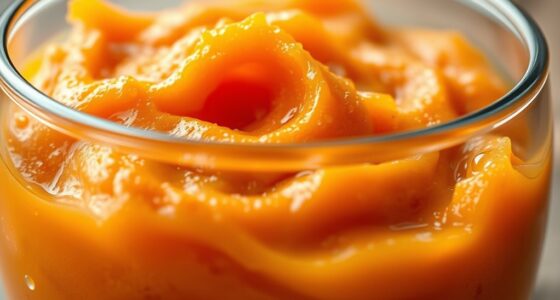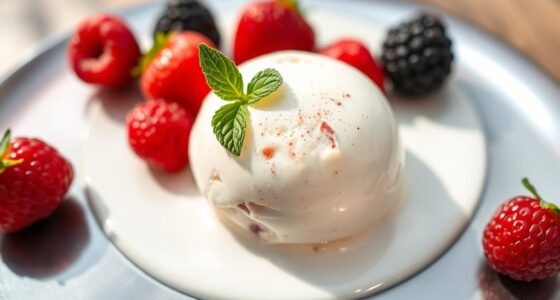Adding a splash of liquor to ice cream lowers its freezing point, making it softer and more scoopable. The alcohol prevents large ice crystal formation, resulting in a creamier texture. The more liquor you add, the more it depresses the freezing point, which might prevent the ice cream from fully freezing if overdone. To master the perfect boozy treat, understanding how each spirit affects texture and freezing is key—there’s much more to discover.
Key Takeaways
- Alcohol lowers the freezing point of ice cream, making it softer and more scoopable after freezing.
- Adding liquor prevents large ice crystal formation, resulting in a smoother, creamier texture.
- Higher alcohol content increases freezing point depression, potentially hindering proper setting if overused.
- Balance of alcohol and cream is essential to achieve desired consistency and prevent slushiness.
- Different spirits affect flavor and texture, requiring adjustments in freezing time and recipe for optimal results.

Combining alcohol and ice cream might seem unusual, but it’s a popular way to create deliciously boozy desserts. When you add liquor to ice cream, you’re not just infusing flavor—you’re also changing how the dessert behaves when frozen. Alcohol’s effect on texture is significant because it influences the way ice cream solidifies, impacting creaminess and smoothness. Unlike water, which freezes solid at 32°F (0°C), alcohol has a much lower freezing point. This leads to an important phenomenon called freezing point depression, where the presence of alcohol prevents the mixture from freezing completely at typical freezer temperatures. As a result, the ice cream remains softer and more scoopable, even after hours in the freezer.
Understanding how alcohol affects texture involves recognizing that the alcohol molecules interfere with the formation of ice crystals. Normally, when you freeze plain ice cream, water molecules bond together to form ice crystals, making the dessert hard and brittle. But when alcohol is present, it disrupts these bonds, creating a softer consistency. This is why a boozy ice cream can stay scoopable and creamy, even after extended freezing. The more alcohol you add, the greater the freezing point depression, which means your dessert will be less firm and more custard-like. That’s why recipes with higher liquor content require a different approach—perhaps slightly less freezing time or a different base recipe—to achieve the desired texture.
The key takeaway is that alcohol’s impact on ice cream isn’t just about flavor; it’s about controlling the final texture. If you’re experimenting with different spirits, keep in mind that a splash of liqueur can make your dessert more indulgent and easier to serve. It also prevents the formation of large ice crystals that can ruin the smooth mouthfeel typical of good ice cream. To get the best results, measure your alcohol carefully, as too much can prevent the mixture from setting properly, turning it into a slush or a semi-frozen liquid. Balancing alcohol and cream ensures you get a luscious, scoopable treat that’s both flavorful and pleasing to the palate.
Additionally, considering the types of spirits used can influence not only flavor but also the overall texture, as different spirits contain varying amounts of alcohol and additives. Ultimately, understanding alcohol’s effect on texture and freezing point depression empowers you to craft boozy ice creams that balance flavor and consistency beautifully. Whether you’re adding a splash of rum to a creamy base or experimenting with other spirits, remember that the key is moderation and precision. With the right approach, you can enjoy a dessert that’s rich, smooth, and perfectly chilled—without turning into a hard block of ice.
Frequently Asked Questions
How Does Alcohol Influence Ice Cream Texture?
You’ll notice that alcohol’s impact on ice cream primarily involves slowing down ice crystal formation. When you add liquor, it lowers the freezing point, which prevents large ice crystals from forming and keeps the texture smooth. This means your ice cream stays creamy longer, as the alcohol disrupts the usual crystallization process. So, a splash of liquor can make your treat more enjoyable by maintaining a velvety consistency.
Can Alcohol Prevent Ice Cream From Freezing Solid?
Yes, alcohol can prevent ice cream from freezing solid because its lower freezing point keeps the mixture softer. When you add alcohol, it slows down alcohol evaporation during freezing, maintaining the flavor enhancement without turning icy. This means your ice cream stays creamy and scoopable longer. Just be careful with the amount; too much alcohol can make it too soft or prevent proper freezing altogether.
What Types of Liquor Are Best for Ice Cream?
This question might be the most exciting thing you’ve ever asked! When choosing liquor for ice cream, consider flavor pairings and alcohol infusion methods. Liqueurs like Baileys, Grand Marnier, or Kahlua add richness and depth, enhancing your dessert experience. Opt for creamy, sweet options that blend well without overpowering the flavor. Remember, the right liquor transforms your ice cream into a decadent masterpiece, making every bite unforgettable.
Does Alcohol Affect Ice Cream’s Nutritional Content?
You might wonder about alcohol nutritional impact on ice cream. Adding liquor doesn’t substantially change the ice cream’s calorie content, but it does add extra calories depending on the amount used. Alcohol doesn’t affect the essential nutrients much, but it can influence the overall nutritional profile slightly. Keep in mind, moderation is key, as excess alcohol can increase calorie intake without providing substantial nutritional benefits.
How Much Alcohol Can I Add Without Ruining the Ice Cream?
When adding alcohol to ice cream, you want to keep the alcohol flavor prominent without ruining the freezing process. Generally, stay under 1/4 cup per quart of ice cream; this amount won’t considerably lower the freezing point or cause it to become too soft. If you add too much, the ice cream may not freeze properly, resulting in a slushy or overly soft texture. Keep it moderate for the best results.
Conclusion
So, next time you add a splash of liquor to your ice cream, remember it’s not just about flavor—it also changes the freezing point unexpectedly. It’s funny how a simple coincidence, like a drop of alcohol making your dessert softer, can turn ordinary treats into delightful experiments. Sometimes, the smallest addition leads to the most surprising results. Enjoy your creatively crafted ice cream, knowing that a little alcohol can make all the difference in your frozen masterpiece.









